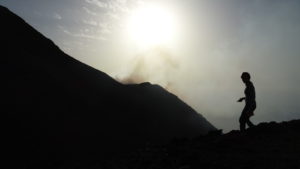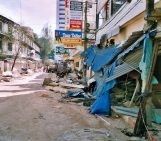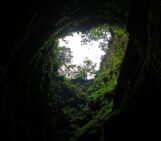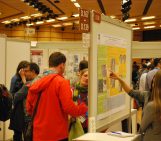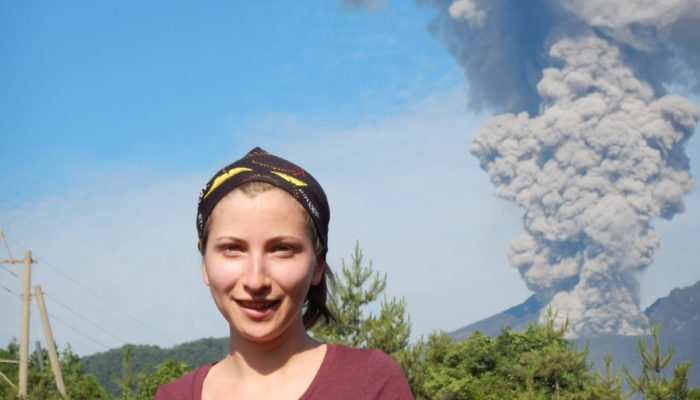
Hello Valeria, thank you for talking with us today! Could you tell us a bit about yourself?
Hi Simon, I’m delighted to talk with you today; thank you for the opportunity!
I originally come from Italy, and I work as a postdoc researcher at Ludwig-Maximilians-Universität (LMU) Munich, in Germany, in experimental and physical volcanology. In particular, I’m working on my DFG funded project about volcanic jet dynamics and their acoustic properties. Besides my research activity, I act as the current Early Career Scientist (ECS) Representative and the blog editor for the Natural Hazards Division. I’m very interested in outreach and science communication. In my free time, I enjoy practising yoga and hiking, and Bavaria is an excellent location for that. I love sci-fi books, tv shows and movies, and I dream of flying to Mars!
As a volcanologist, you investigate the dynamics of eruptions but have also worked on methods used to detect distant volcanic atmospheric clouds. Could you tell us more about your research?
My main research focus is on understanding better explosive eruption dynamics. To do so, I use a combination of laboratory experiments and field observations, looking at parameters that can be analysed in both scenarios. These parameters are, for example, the velocity of particles or pyroclasts spewed by the volcano or the acoustic emission of the eruption.
I use a shock tube in the laboratory, which simulates a downscaled volcano while keeping physically meaningful explosive dynamics. The advantage of the laboratory experiments is that I can measure particle velocity, and I know the starting conditions that produced that outcome. A starting condition is, for example, the system geometry. I can then try to describe dynamics observed at volcanoes with the knowledge gained from the experiments. The comparison is not straightforward cause nature is much more complex. Still, it’s a step forward in understanding it or a part of it. All observations collected can then be used to produce more accurate models of eruptions and their evolution, which is crucial for hazard assessment.
I focus on the dynamics that happen very close to a volcano’s crater in all the above. Still, during a postdoc at Università degli Studi di Padova, Italy, I had the opportunity to work on volcanic clouds once they reach and get dispersed in the atmosphere. I applied a particular satellite-based technique, GNSS Radio Occultations, traditionally used for meteorological analysis, to detect volcanic clouds and quantify their altitude. The latter is important to define safe aviation routes after a large eruption, for example.
A series of recent volcanic eruptions have captivated the media this year, from the Icelandic Geldingadalir to La Soufrière on the Caribbean island of Saint Vincent. A common thread through these events were how people, including those local to the surrounding area, reacted to eruptions in ways many thought were unexpected: people refused to evacuate their homes or, in the case of Geldingadalir, watched lava from the flow’s edge. As a researcher and communicator who specialises in natural hazards, could you tell us why people react in such surprising and complex ways to hazards, and how this shapes the way you communicate your own research?
This is an incredibly complex and interesting question and the subject of ongoing research. It is complicated because risk perception can be disconnected from actual measurements. And it originates in large part from a complex mixture of an individual’s experiences, feelings, and values. On top of that our interactions with other people, what specific information on the media we’re exposed to, the certain images we see, can alter our perception of risk. All this make up for all the different reactions we may observe.
It means that, despite our very good intentions as scientists to stick to the hard facts and communicate them, good communication passes through by understanding your audience and their background, and possibly trying to have an actual conversation with them. Here I’m citing Iain Stewart at the #vEGU21 short course about science outreach; I try to keep these principles in mind when I communicate my research and volcanic hazards to the broader public.
Academic terminology can be a barrier to good science communication when interacting with non-experts, such as the broader public. In natural hazards communication the terms “hazard” and “disaster” are commonly used, but what is the difference between a hazard and a disaster?
Stating the definitions: a hazard is a dangerous phenomenon that can cause damage to properties and infrastructure as well as loss of lives. In comparison, a disaster is an actual disruption of the function of a community following a hazardous event, a calamity. For example, a flood following heavy rain is a natural hazard. In contrast, a flooded town with the water level reaching houses’ ceiling is a disaster. Hazard and disaster are connected in a complex way that includes both the nature of the phenomenon and the characteristics of the community or the society impacted.
At times hazard, risk and disaster terminology may get used to express the same concept causing confusion; we have covered in more detail this topic on a Natural Hazards 101 series on the blog last fall; check it out if you haven’t yet!
A prominent theme in the field of natural hazards is the shift from using terms like “natural disasters”. Could you tell us why terms like natural disasters are contentious?
I have to admit that I used the term “natural disaster” in the past. I often read it in news outlets after a natural hazard event. It is even still used by organisations and institutions dealing with hazards and disasters at times. However, about a year ago, I stepped upon the #NoNaturalDisaster manifest, and I found their point strikingly accurate and straightforward. Attributing “natural” to the term disaster is misleading because it promotes the view that if the occurrence of a natural hazard impacts badly on a community, the negative impacts are an inevitable consequence of the phenomenon with less or no responsibility from the human governing structure. To make a practical example, let’s take a magnitude 7 earthquake; it is pretty strong. If it occurs in the middle of nowhere, there will be no disaster to be accounted for. But suppose the same earthquake happens in a very densely and vulnerable inhabited area. In that case, that’s a recipe for disaster. But is it the fault of the earthquake only (pun intended)? I don’t think so.
Do you know that Jean-Jacques Rousseau already debated on the non-natural character of disasters in the 18th century? Find it out on the NH blog; Giulia Roder interviewed one of the #NoNaturalDisaster campaign founders, Kevin Blanchard.
You’re also the Early Career Scientist Representative for the Natural Hazards (NH) Division – could you tells us what that involves?
For me, it means to be the point of contact and connection for the early career scientists’ community of the Natural Hazards Division with the rest of the Union structure. Bring up issues, discuss and propose solutions within the Division and with the other Divisions’ Representatives to make the Union and related initiatives more inclusive, more accessible. Help shape the annual General Assembly with scientific initiatives and activities to foster soft and transversal skills. Last but not least, there is an excellent opportunity for social and professional networking among peers and senior researchers from a variety of backgrounds.
How can our readers become involved with the Natural Hazards Division?
Together with a brilliant team of 6 regular editors, we take care of the Division blog. We are always looking for guest blog posts, so if you’d like a platform to talk about your natural hazards research in broader terms, we are here for you. Also, you can express your interest to become a regular editor.
But the Natural Hazards ECS team is bigger than the blog team only. Part of the team is currently working on a series of webinars within the #EGUcampfires framework that should start after the summer: stay tuned!
We also have a Slack workspace that we use to organise these different activities and to network. Drop an email to: ecs-nh@egu.eu if you are interested. We are going to start talking about the 2022 General Assembly activities very soon too!
What’s the one key message you’d like our readers to leave with, or myth you’d like to bust, about natural hazards?
I would like to say that natural hazards can be dangerous but can be spectacular too (and safe to observe from a distance!). They shape our Earth, and they make it the fantastic planet that it is. We cannot subside them; so, we work on understanding them better, forecasting them and their worst effects better, which is extremely important. To that, and very crucially, we work hard towards solutions to build resilient societies that can cohabit well with the phenomena around us.
Finally, what are your next steps?
I’m heading towards the end of my current project. So, I’m thinking about what to do next while I’m working on analysing the latest experimental data collected. I’m also still hoping to do a fieldwork campaign in September to collect jet noise from Stromboli volcano, Italy. However, in between pandemic restrictions and my target volcano’s “bad” behaviour, currently preventing me from working safely on its summit, I’m unsure if it will happen. Ah! The beauty -and the beast- of working in unpredictable times with unpredictable phenomena!
Thank you for spending your time with us today and for answering all our questions!

